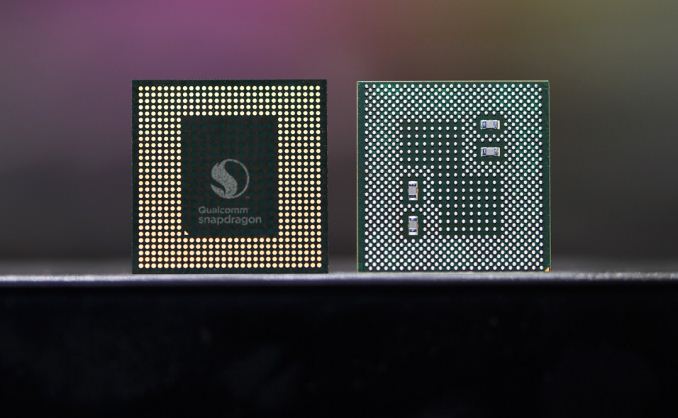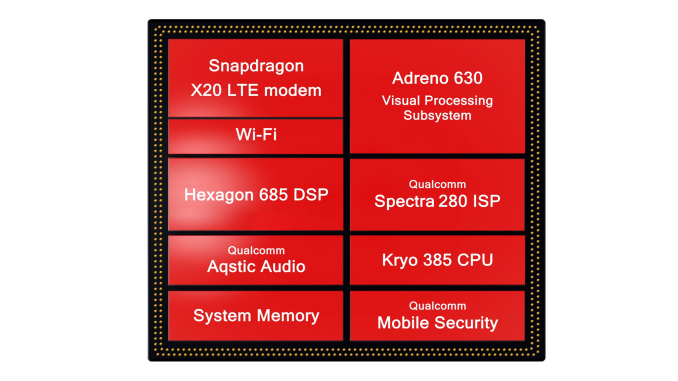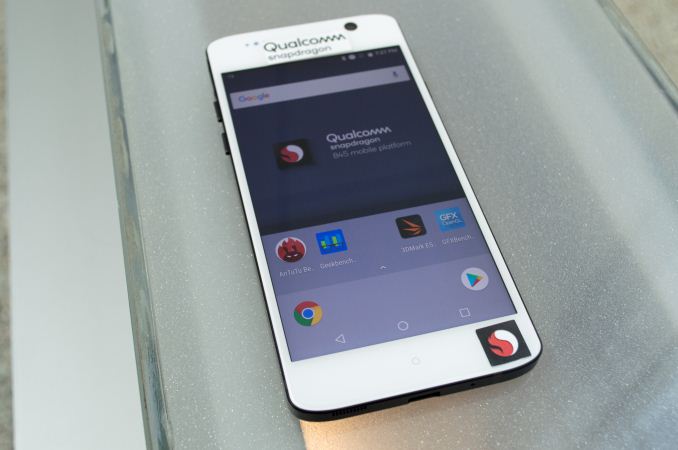The Snapdragon 845 Performance Preview: Setting the Stage for Flagship Android 2018
by Ryan Smith & Andrei Frumusanu on February 12, 2018 12:30 AM EST- Posted in
- Mobile
- Snapdragon
- Qualcomm
- Smartphones
- SoCs
- Snapdragon 845

In what has become an annual tradition for Qualcomm, the company has once again opened the doors of their San Diego headquarters to the press to take a preview look at the next generation of their flagship mobile platform. These events have been going on for several years now, and have become an integral part of how Qualcomm approaches the public with their wares; preview events not only let them set expectations, but to get the word out to technically-minded audiences in a vendor-neutral manner. Rather than being one part in the next flagship smartphone, preview day means that everything can be about Qualcomm and the platforms that they have created.
Late last year Qualcomm announced the Snapdragon 845 platform, the successor to 2017’s Snapdragon 835. Implementing a number of important architectural improvements over its predecessor, the Snapdragon 845 gets to follow-up on what ended up being a rather well-received platform in the Snapdragon 835, and to see if Qualcomm can maintain their momentum. Qualcomm used their December event to release a good bit of info on the 845 in advance, so we’ve already had a chance to see what Qualcomm is planning architecturally. And now with the preview event we finally get to see how all of this comes together with a look at the platform as a whole.
Whenever discussing the state of affairs of Qualcomm’s flagship SoCs, I always struggle not to tie it to the Snapdragon 810 in some fashion. Which not to beat Qualcomm over the head for past mistakes – in that case a poorly thought out response to Apple – but rather because it serves as a such a great point of reference for discussing the company’s SoC development as a whole. 810 was arguably the company’s low point, so everything since then has been part of a rather remarkable upward trajectory for the flagship Snapdragon. Even though Qualcomm has been leading the pack in high performance SoCs for several years now, last year’s Snapdragon 835 in particular really felt like Qualcomm was in that position for all-around technical capabilities and not merely because of size, momentum, and the realities of LTE licensing.
All of this means that there’s a lot riding on the Snapdragon 845, just in a different and less obvious way than before. Qualcomm has redeemed themselves from the 810 and it’s not a question of whether they can put together a great SoC, but instead it’s a question of how they will follow up upon a great SoC like the 835.
| Qualcomm Snapdragon 845 vs 835 | |||
| SoC | Snapdragon 845 | Snapdragon 835 | |
| CPU | 4x Kryo 385 Gold (A75 derivative) @ 2.8GHz 4x256KB L2 4x Kryo 385 Silver (A55 derivative) @ 1.77GHz 4x128KB L2 2MB L3 in DSU |
4x Kryo 280 Gold (A73 derivative) @ 2.45GHz 2MB L2 4x Kryo 280 Silver (A53 derivative) @ 1.90GHz 1MB L2 |
|
| GPU | Adreno 630 | Adreno 540 @ 670/710MHz | |
| Memory | 4x 16-bit CH @ 1866MHz LPDDR4x 29.9GB/s 3MB system cache |
4x 16-bit CH @ 1866MHz LPDDR4x 29.9GB/s |
|
| ISP/Camera | Dual 14-bit Spectra 280 ISP 1x 32MP or 2x 16MP |
Dual 14-bit Spectra 180 ISP 1x 32MP or 2x 16MP |
|
| Encode/ Decode |
2160p60 10-bit H.265 720p480 |
2160p30 (2160p60 decode), 1080p120 H.264 & H.265 |
|
| Integrated Modem | Snapdragon X20 LTE (Category 18/13) DL = 1200Mbps 5x20MHz CA, 256-QAM UL = 150Mbps 2x20MHz CA, 64-QAM |
Snapdragon X16 LTE (Category 16/13) DL = 1000Mbps 3x20MHz CA, 256-QAM UL = 150Mbps 2x20MHz CA, 64-QAM |
|
| Mfc. Process | 10nm LPP | 10nm LPE | |
The answer to that comes in the form of the Snapdragon 845, an interesting SoC that is a “tock” design if there ever was one. Qualcomm doesn’t get the advantage of an entirely new manufacturing node – the 845 is being made on Samsung’s second-generation 10LPP process, a refined version of 10LPE used for the 835 – so Qualcomm’s improvements are rooted almost entirely in architecture rather than a mix of architecture and manufacturing. Which is to say that it’s a bit of an uphill challenge for the company, but the flip side of that argument is that it’s going to be a chance for Qualcomm’s architectural engineers to take attention front and center.
What the Snapdragon 845 entails then, as we originally learned late last year, is a series of upgrades and overhauls across all the various subsystems of the SoC. Arguably the biggest news here is that Qualcomm’s latest-generation Kyro 385-series CPU cores are derived from ARM’s Cortex-A75 and A55 designs, and that the resulting SoC is the first to employ ARM's DynamiQ CPU cluster organization. DynamIQ enables the various different CPU cores within an SoC to be hosted within the same cluster and cache hierarchy, as opposed to having separate discrete clusters with no shared cache between them, allowing for finer-grained and more efficient approaches to when and how various clusters are powered up. Meanwhile on the GPU side, the notoriously tight-lipped GPU group over at Qualcomm has confirmed that the Snapdragon 845 implements the first Adreno 600 series GPU, which in turn is the first new GPU architecture from Qualcomm in a couple of years and promises some significant performance improvements.
Outside of the core processor architecture, the changes in the rest of the SoC are perhaps not quite as dramatic, but still important to the platform as a whole. This includes, of course, Qualcomm’s latest and greatest LTE modem, the Snapdragon X20, upgrading Qualcomm’s LTE capabilities category 18. Both the camera ISP and Hexagon DSP have also been upgraded as well with the introduction of the Spectra 280 and Hexagon 685, which Qualcomm will be leveraging for camera image quality improvements and their stake in the modern mobile AI race respectively. Finally, the SoC also includes the latest version of the company’s Aqstic audio codec, which although audio has not traditionally been heavily promoted by the company, will be an increasingly important part of differentiating itself from other high-performance mobile SoCs.
Getting down to the heart of matters then, this year’s flagship Snapdragon platform preview is a lot like last year’s. We’re once again taking a look at a Qualcomm Reference Design (QRD), which is a fully functional smartphones in a slightly oversized, utilitarian chassis used for hardware testing and software development. The Snapdragon 835 QRD was a 5.5-inch equivalent phone, and for the 845 QRD Qualcomm has stuck with much the same. The device itself is unremarkable, featuring a 1440p LCD and 6GB of LPDDR4X memory, but it’s otherwise typical of the class of Snapdragon 845 devices we expect to see starting a bit later this year.
Similarly, while this is still a preview, final device performance shouldn’t be too much different from what we see with Qualcomm’s QRD. Vendors do make customizations to both hardware and software, so how a device’s cooling system is built or how aggressive the power management is configured will have an impact on final performance. But as far as stock performance goes, the QRD is about as neural as it gets, if not a slightly idealized case for the platform as it allows Qualcomm to optimally configure the phone themselves.












140 Comments
View All Comments
Eximorph - Sunday, February 18, 2018 - link
You should read a little before post comments. The speed of the gpu depends on the api Thats why apple change from open gl es to metal beacus metal is a low overhead so the performance is higher. And thats why when some one test a gpu have to do it under fair conditions and thats where 3Dmark is good. And like you can see even the adreno 530 on the same api have a better performance than the A11 gpu. Even on t-rex onscreen the performance of the new A11 gpu is the same has the adreno 530. 59 for A11, 60 for the adreno 530 on the oneplus 3t. one more time, apple today day Is almost 3 years behind. Vulkan is have been you in some game today day but you want to know whats the funny thing here, vulkan is on version 1 and offer the same persomance has metal and metal is on version 2 hahahah.Ratman6161 - Thursday, February 15, 2018 - link
"Good on Qualcomm for catching up but still 6 months to a year behind"I guess it depends how you define behind. With my trusty old (and completely paid for) Note 5, I have had a phone since 2015 that is plenty fast for everything I do. Do its all just academic for me. The days when I needed a faster CPU are long since over.
SoC lover - Friday, March 2, 2018 - link
A-11 bionic is just only 6 cores but still a flagship and powerful while snapdragon 835/845 has 8 cores so im thinking what if apple make a new chipset with 8 cores thats would be soo powerfulmfaisalkemal - Monday, February 12, 2018 - link
i think why anandtech got that score because of the device run on cold condition. score from futuremark got from normal condition.BenSkywalker - Monday, February 12, 2018 - link
We really should tip our hats to Qualcomm's legal team for this one. It is amazing their engineers have managed to push out a GPU that can edge out the Tegra X1 a mere three years after it came out.Slingshot Ex- 5360 graphics on a three year old SoC. Really shows how what truly matters in this market is top tier lawyers, and some fourth tier engineers.
Andrei Frumusanu - Monday, February 12, 2018 - link
One uses ~12 watts and the other uses ~4W, great comparison there.BenSkywalker - Monday, February 12, 2018 - link
Two things, one is that your power numbers are going to have to be sourced, the highest number I could ever find was 10 watts(and that was using a UE4 torture test). The only power draw numbers I could find for Manhattan had is sucking down a whopping 1.51 watts for the GPU(just the GPU and clocked to match some crappy Apple SoC's performance).https://www.anandtech.com/show/8811/nvidia-tegra-x...
Second thing- 20nm vs 10nm. On an engineering basis, this is a sad part. Qualcomm's legal posturing is the only reason they are remotely viable.
We are being held back to a staggering degree because of Qualcomm's strong arm tactics. The performance numbers speak for themselves, they are years behind.
Andrei Frumusanu - Monday, February 12, 2018 - link
That's the power on a Shield TV at maximum performance; source me. You're claiming that QC only reached now performance level so it's only fair to compare power at that level.Qualcomm is the one far ahead, your conspiracy theories make no sense.
BenSkywalker - Monday, February 12, 2018 - link
You are comparing the power draw of an entire device to the SoC alone, and you are comparing a 20nm part to a 10nm part on your just plain wrong power numbers.I linked it- running Manhattan the x1's GPU was using less then half the power that the 845 was reporting- the comparison wasn't exactly fair as they weren't measuring the same thing, but it is closer to accurate then what you are trying to imply. Also, 20nm vs 10nm LPP- are you being intentionally obtuse here, or do you not have a clue what you are talking about whatsoever?
This part, at least on the GPU end, isn't just bad, it is pathetic. It can barely edge out a three year old SoC. It is a joke.
darkd - Monday, February 12, 2018 - link
The x1 by itself is a 10-12W TDP part. You can Google this easily. Qualcomm SoCs are 4-5W typically. Also note you are comparing power draw at 33 fps of a different benchmark that runs ~40% faster (Manhattan 3.0 vs. 3.1), which makes no sense.The x1 at peak can hit ~60 fps on Manhattan 3.0. The 835 from last year can also do that, but at 2-3x less power.
If you want to talk the ~33 fps on Manhattan 3.0 where the 1.5W you mentioned was measured, then the Adreno 430 can do that about 3 years ago. Because that's peak clocks for the 430 it would likely be using 2+ W GPU power, which is more. The x1 was more power efficient than the 430, congrats. It hasn't been since then, however, as Qualcomm improved their Manhattan score 60-70% in 530. All of these number are easily obtained on gfxbench.com.
And I dunno what legal study you've done, but to imply Qualcomm lawyers can keep OEMs from using competitor SoCs is completely unfounded. Many of them have and do use other SoCs. They tend not to use Nvidia for mobile anymore, however, as the recent Nvidia parts all have too high a TDP.